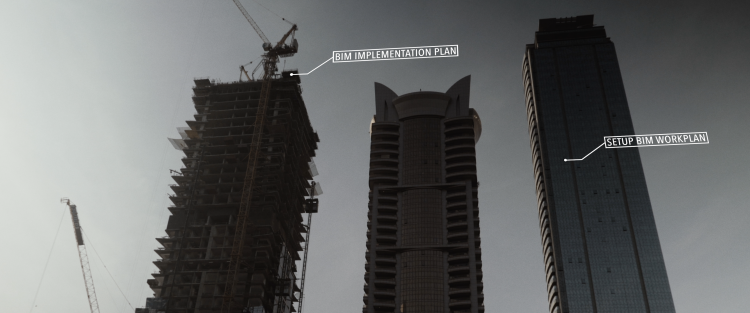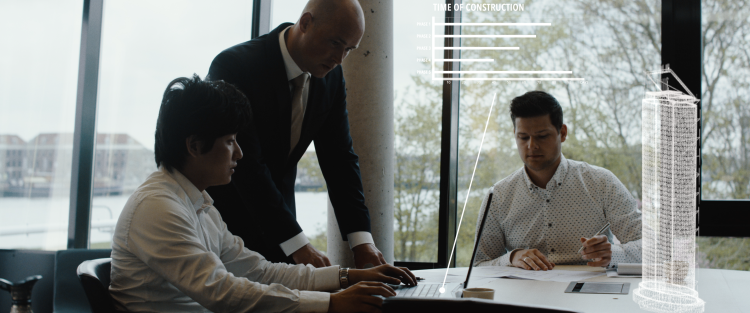



Welcome to our series of blog posts on Building Information Modelling (BIM). In this series, we explore the various dimensions of BIM, including 8D, 9D, and 10D BIM.
Read more about the D's of BIM:
10D BIM (Building Information Modeling) refers to a highly advanced form of BIM that integrates various data sources and technologies to improve the management and control of construction projects. Here are some of the key features of 10D BIM:

One of the key features of 10D BIM is the use of virtual reality elements, which enables project managers, architects, and engineers to visualize and simulate the building design and construction process before it takes place. This allows for early identification and resolution of potential issues or conflicts, leading to a more efficient and cost-effective construction process.
The use of virtual reality elements in 10D BIM provides several advantages to construction companies. Firstly, it allows for a more immersive and interactive experience of the construction process, enabling stakeholders to better understand and engage with the project. Additionally, it helps in improving communication and collaboration between various teams and departments involved in the construction process, leading to better coordination and reduced delays. Moreover, the use of virtual reality elements can help in improving safety by enabling workers to identify potential hazards and risks before they occur.
Despite the many advantages of using virtual reality elements in 10D BIM, there are also several obstacles to implementing this technology. One of the main challenges is the cost and complexity of setting up the necessary hardware and software infrastructure required for virtual reality. Additionally, there may be a learning curve for workers who are not familiar with virtual reality technology, which can lead to additional training costs and delays in the construction process. Finally, there may be concerns about data security and privacy, which need to be addressed when implementing virtual reality elements in construction projects.
To successfully implement the Virtual Reality Elements of 10D BIM and tackle the obstacles, companies can take several steps. Start by investing in the necessary hardware and software infrastructure required for virtual reality, and ensure that you have skilled personnel to manage and operate this technology. Secondly, conduct training sessions to familiarize workers with the virtual reality elements and their benefits. This will help in shortening the learning curve and improving worker engagement and productivity. Additionally, companies can address concerns about data security and privacy by implementing appropriate measures and protocols to protect sensitive information. Finally, companies can collaborate with their partners and stakeholders to improve communication and coordination, thereby reducing delays and improving the overall efficiency of the construction process. By taking these steps, construction companies can successfully implement the Virtual Reality Elements of 10D BIM and reap the benefits of this advanced technology.

Real-Time Monitoring and Control is a key feature of 10D BIM, which provides real-time visibility and management of construction projects. It involves the use of sensors, cameras, and other monitoring technologies to collect and analyze data about various aspects of the construction process, including progress, quality, and safety. This data is then used to make informed decisions and take corrective actions in real-time.
The advantages of Real-Time Monitoring and Control in 10D BIM are numerous. Firstly, it allows project managers to have a comprehensive and up-to-date view of the construction process, enabling them to identify and address issues as soon as they arise. This can lead to significant time and cost savings by avoiding delays and rework. Additionally, real-time monitoring and control can help in improving safety by enabling early identification and mitigation of potential hazards and risks. Moreover, it enables stakeholders to make data-driven decisions, leading to better coordination and collaboration between teams.
Despite the many advantages of Real-Time Monitoring and Control in 10D BIM, there are also several obstacles to implementing this technology. One of the main challenges is the cost and complexity of setting up the necessary hardware and software infrastructure required for real-time monitoring and control. Additionally, there may be concerns about data privacy and security, which need to be addressed through appropriate measures and protocols. Finally, there may be resistance from workers and stakeholders who are not familiar with this technology, leading to additional training costs and delays. Overcoming these obstacles requires a combination of investment, training, and collaboration to ensure successful implementation of real-time monitoring and control in construction projects.
To successfully implement Real-Time Monitoring and Control in 10D BIM and tackle the obstacles, companies can take several steps. Start by investing in the necessary hardware and software infrastructure required for real-time monitoring and control, and ensure that you have skilled personnel to manage and operate this technology.
Secondly, conduct training sessions to familiarize workers with real-time monitoring and control and its benefits. This will help in shorting the learning curve and improving worker engagement and productivity. This will also help in creating support under the workers. Additionally, construction companies can address concerns about data security and privacy by implementing appropriate measures and protocols to protect sensitive information.
Finally, construction companies can collaborate with their partners and stakeholders to improve communication and coordination, thereby reducing delays and improving the overall efficiency of the construction process. By taking these steps, construction companies can successfully implement Real-Time Monitoring and Control in 10D BIM and reap the benefits of this advanced technology.
A large-scale hospital construction project implemented 10D BIM to manage the project's complex design and construction processes. By integrating Virtual Reality Elements, Real-Time Monitoring and Control, and Automated Engineering Planning and Control, the project team was able to streamline their operations, reduce costs, and improve the overall quality of the construction process. Despite some initial challenges, such as the need for worker training and the complexity of infrastructure, the project team reported significant benefits, including improved communication, reduced construction time, and increased project efficiency.
Automated Engineering Planning and Control is a key feature of 10D BIM, which involves the use of advanced algorithms and machine learning to automate various aspects of the engineering planning and control process. This includes tasks such as scheduling, resource allocation, and risk analysis, among others. By automating these tasks, construction companies can reduce the time and effort required for manual planning and control, and improve the accuracy and efficiency of the process.
Automated Engineering Planning and Control in 10D BIM offers several advantages to construction companies. By automating the planning and control process, construction companies can significantly reduce the time and effort required for manual planning and control, leading to cost savings. This is because manual planning and control can be time-consuming and error-prone, requiring a significant amount of human resources to manage. With automation, the process becomes more efficient and streamlined, leading to improved productivity and profitability.
In addition to time and cost savings, Automated Engineering Planning and Control in 10D BIM can also improve the accuracy and efficiency of the planning process. This is because automation enables the use of advanced algorithms and machine learning to analyze data and generate insights that would be difficult or impossible to obtain through manual methods. By using these insights, construction companies can make better-informed decisions and improve the overall quality of their projects.
Furthermore, Automated Engineering Planning and Control can help in identifying and mitigating potential risks and issues, leading to improved safety and quality of the construction process. By analyzing data in real-time, construction companies can identify potential risks and issues before they become significant problems, enabling them to take corrective actions to avoid delays and rework. This can also improve the safety of the construction process by enabling early identification and mitigation of potential hazards and risks.

10D BIM represents the next generation of Building Information Modeling technology, offering advanced capabilities for construction companies to manage and control every aspect of the construction process in real-time. By integrating Virtual Reality Elements, Real-Time Monitoring and Control, and Automated Engineering Planning and Control, 10D BIM provides construction companies with a comprehensive platform to streamline their operations, reduce costs, and improve the overall quality and safety of their projects. While there are obstacles to implementing these technologies, such as the cost and complexity of infrastructure and the need for worker training, the benefits are significant, making 10D BIM a valuable investment for any construction company looking to stay ahead of the curve in today's fast-paced construction industry.
Copyright © 2024 The BIM Engineers. All Rights Reserved | Design & Developed by Prettify Creative